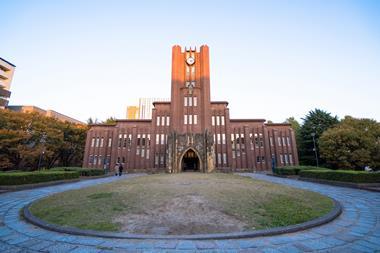Facing a worsening labour shortage exacerbated by the pandemic Japan is taking action. This includes a pledge to make 400,000 places available to international students by 2033, increasing funding for an elite group of universities and making it easier for foreigners to live and work in Japan. The hope is that this will strengthen Japan’s position in an increasingly competitive global higher education market which has close to 3 million students.
Prime minister Fumio Kishida has introduced new policies to revitalise Japan’s labour force as the country deals with an ageing population and declining birth rate – reaching a record low in 2022 with just 7.2 births per 1000 people. Despite efforts to increase the country’s birth rate, the harsh reality is that Japan will struggle to maintain an economically active workforce that can support its population unless steps are taken. Encouraging international students to study and settle down in Japan long term is the simplest solution says Hiroshi Ota, a researcher who studies student mobility at Hitotsubashi University.
Higher education has not been immune from the problems affecting Japan’s workforce. The number of students opting to do a PhD has dropped by 20% over the past 10 years. ‘This means that our share of doctoral students within the world is inevitably decreasing … nobody wants to have such results. So, we want to change the scenario for the future,’ says Akiyoshi Yonezawa, a higher education researcher at Tōhoku University. Employers tend not to value postgraduate qualifications, which means there is little incentive for students to pursue them. ‘Many people say the cost of getting a PhD outweighs the benefits in Japan,’ says Ota, adding that salaries are the same regardless of level of education. Those who do graduate with a PhD face job insecurity with very few academic positions available at Japan’s universities. ‘A PhD means your job prospects are very narrow so young Japanese people make the more logical choice … not to get a PhD,’ adds Ota.
This has indirectly resulted in problems when it comes to the recruitment and retention of women within academia in Japan. ‘Even the professors face difficulty to survive in a male-dominated society,’ says Yonezawa.
‘Promotion is slow’
‘Japan has a peculiar hiring system,’ Ota explains. ‘This makes it difficult to hire women and their promotion is very slow.’ Ota identifies the root cause of this complex problem originating in Japan’s preference of membership-based employment, where everyone is hired under the same conditions with emphasis on group harmony and loyalty to the company, rather than job-based employment which focuses on skills and knowledge. Ota says that globalisation has created a shift in employment, but it is slow and not widespread across Japan. To fully realise this growth, Kishida has set out a plan to promote inclusion and diversity with initiatives being rolled out in universities that have a greater emphasis on the UN sustainable development goals and gender equality.
Japan has had plans to increase its research output for years and this year revealed a new strategy to create an Ivy League system like the US. Tōhoku University has been named one of the first recipients to receive investment from this ¥10 trillion (£64 billion) fund. ‘We will have around 7 to 10% increase of our annual income from next year for 25 years,’ says Yonezawa. This should give the university the funding to invest in attracting young talent.
The proposal incorporates a radical restructuring of the university giving its junior researchers far more autonomy. ‘We give them the position of the principal investigator (PI) at an early stage and provide a tenure track position … and by doing so they are motivated to do innovative research,’ adds Yonezawa. More support roles are also in the pipeline at the university, including mental health services to help students. The government has also injected extra funding into 111 universities to expand their science departments as the number of university students enrolled in Stem is 15% lower than at its peak in the late 1990s. There has also been a decrease in the number of papers published by Japanese researchers since the early 2000s – particularly noticeable in the number of highly cited papers – and number of patent applications which has dropped by 10% between 2005 and 2018. ‘The economic factor is always the big factor … if we can provide a high salary [for researchers] it is more attractive,’ says Yonezwa.
Language barriers
‘Japan has a very strong tradition to foster talented researchers within our own system,’ Yonezawa explains. ‘In some fields 90% of the professors get a PhD in Japan and then they become a professor in Japan … and are highly connected with the Japanese community.’ He says that this means that obstacles regarding language are tied very closely to tradition which is why addressing it has taken so long. ‘We are not really used to teaching in an English-speaking system – that is the very big problem,’ he says, adding that overcoming this significant language barrier will allow Japan to become more cosmopolitan and create a research culture that will attract global talent. Japanese universities have started offering more English classes and also encourage students and staff to converse in the language. More Japanese universities now offer courses fully taught in English and the government is ‘not only supporting the study, but also the job search, job placement. Visas are also becoming easier [to obtain],’ says Oka.
Japan is not alone in south-east Asia when it comes to a shortfall of domestic students. Both South Korea and Taiwan have announced plans to increase international students and provide additional support to obtain working visas. ‘For economic development, we need the people,’ comments Ota. South Korea has a five-year plan to increase the quota of government scholarships, primarily aimed at universities outside of larger urban areas and those with Stem programmes. Taiwan is offering scholarships to reach its goal of over 300,000 international students. ‘All three cases are faced with very serious demographic change. There is shared structure … [a] relatively hierarchical system but the approach for the funding and attracting international students are so different,’ Yonezawa says.

















No comments yet